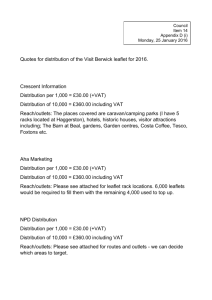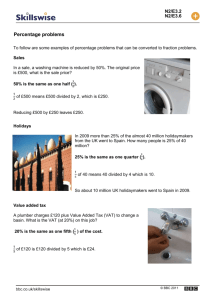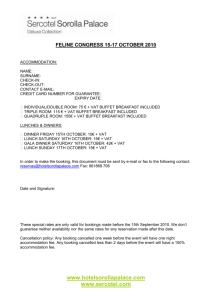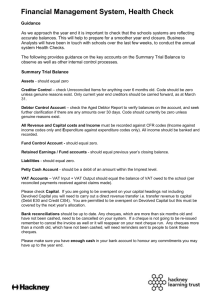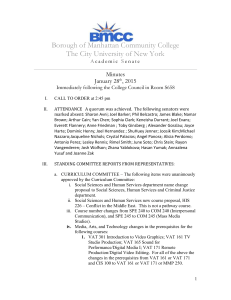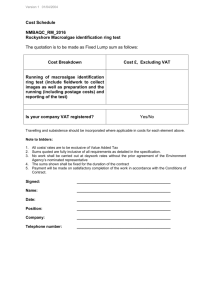VAT Fraud in the European Union
advertisement
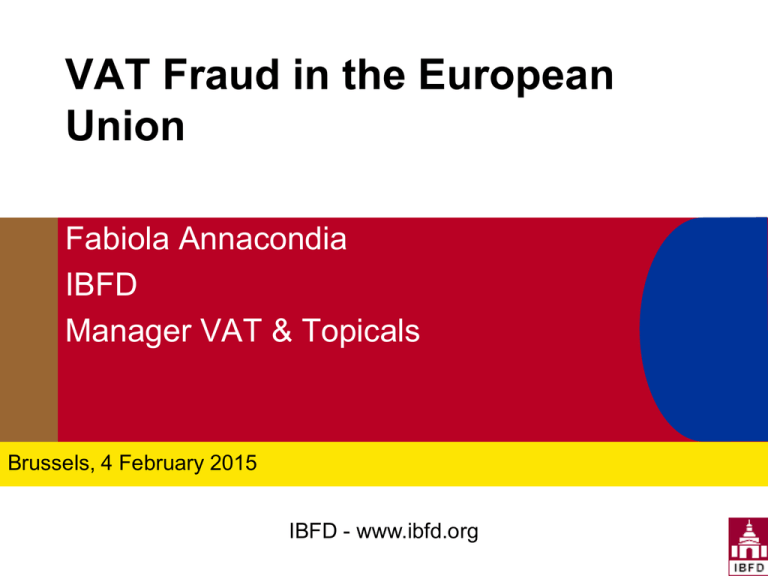
VAT Fraud in the European Union Fabiola Annacondia IBFD Manager VAT & Topicals Brussels, 4 February 2015 IBFD - www.ibfd.org EU VAT legislation 1954: Value added tax (VAT) was first introduced in France. 1967: the Member States of the European Economic Community agreed to replace their national turnover tax systems with a common VAT system. . . . 2015: Member States of the European Union – 28 Member States apply the EU VAT legislation (EU VAT Directive, 28 VAT National Acts, EU Implementing Regulations, etc.) 2 © 2015 IBFD EU VAT legislation VAT in the EU is regulated by a Council Directive. Any change to the regime require a unanimous decision by the 28 Member States. High turnover of Presidency of the Council of the European Union means reform takes time. Pressure from business to modernize, simplify and harmonize VAT across the Member States. Pressure from tax administration to increase VAT revenue and reduce the VAT gap. 3 © 2015 IBFD Future of VAT proposed (Green Paper) December 2011 the Commission adopted a Communication on the Future of VAT (Green paper) Fundamental characteristics that must underlie the new VAT regime and intended to create a: • simpler (clear and transparent rules on VAT registrations, VAT returns and compliance), • more efficient (supporting Member States: propose the removal of exemptions and limiting reduced rates without effecting Member States revenue); and • more robust (preventing fraud and closing the “VAT Gap”) VAT system in the EU tailored to the single market 4 © 2015 IBFD VAT Fraud - Action plan (White Paper ) − one-stop-shop arrangements: further extension 1 January 2015 − VAT information on web portal − tripartite VAT Forum (Commission, Member States and businesses) 2012: Expert Group + VAT Forum − quick-reaction mechanism(accelerated derogation procedure - RCM) − anti-fraud measures, cross-border audit teams (Fiscalis 2020) Reg. 1286/2013 − standard VAT return – (Proposal COM(2013) 721) − public bodies, transport, non-profit organizations (studies – consultations) − restriction of reduced rates (consultation report 2013) − efficiency and effectiveness of tax administration − co-operation with third countries and between VAT and customs − split payment – data warehousing – SAF-T (Standard Audit File - Tax) 5 (Russia, Norway) © 2015 IBFD VAT Gap – Reverse charge mechanism VAT Gap: Expected VAT revenue and VAT actually collected (estimated EUR 177 billions – Study 2014) VAT Gap: non-compliance, VAT fraud, bankruptcies and insolvencies, statistical errors, delayed payments, legal avoidance, others. VAT Gap (< 30%) - Reverse charge mechanism (QRM) (type of transactions) Italy 32% 6 Slovak Rep. 33% 11 Lithuania 36% 5 Latvia 37% 3 Greece 38% 2 Romania 44% 9 6 © 2015 IBFD Optional reverse charge mechanism Member States may, until 31 December 2018, apply the reverse charge mechanism to: – transfers of CO2 emission and similar allowances (Article 199a(1)(a) and (b)) – mobile telephones (Article 199a(1)(c)) – integrated circuit devices (Article 199a(1)(d)) – gas and electricity supplied to taxable dealers(Art. 199a(1)(e)) – gas and electricity certificates (Article 199a(1)(f)) – telecommunications services (Article 199a(1)(g)) – game consoles, table PCs and laptops (Article 199a(1)(h)) – cereals and industrial crops, including oil seeds and sugar beets (Article 199a(1)(i)) – raw and semi-finished metals (Article 199a(1)(j)) (Article 199a) 7 © 2015 IBFD Missing-trader fraud VAT: broad base + high tax rate → perfect conditions for fraud Goods: − low value added Services: − high value added not suitable for fraud, unless input tax can be avoided: − intra-Community acquisition − postponed accounting (transfers of CO2 emission allowances and other tradable services) Victim ("innocent" trader) to be persuaded by: − low purchase price, or − intermediate supplier in pre-arranged deal with third party 8 © 2015 IBFD Missing-trader fraud (Carousel fraud) NL BG (VAT rate: 21%) (VAT rate: 20%) payment 100 supply of goods (100 + 0%) A "conduit company" 9 "missing trader" supply of goods 95 + 19 VAT supply of goods (100 + 0%) payment 100 B 20 20 19 payment 114 C BG tax authorities 19 "broker" or "innocent trader" © 2015 IBFD Options to recovery of revenue loss Recovery of the revenue loss from the "innocent trader": − denial of C's VAT deduction in respect of B's invoices, or − application of joint-and-several-liability provision − correction of zero rate on C's subsequent supply to A, or New legislative measures (COM(2008) 109): − abolition of the zero rate for intra-Community supplies → 15% − introduction of the reverse charge mechanism applicable to domestic supplies − increase frequency recapitulative statements(Directive 2008/117) − real-time VAT collection 10 © 2015 IBFD



